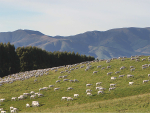OPINION: The lucky country is New Zealand.
We have water in abundance. It falls out of the sky and flows out to the sea. It is termed 'renewable'.
A series of reports from Berl (Business Economics and Research Ltd) make the abundance clear: New Zealand has about twice the quantity of freshwater on its area than United Kingdom, and about four times that of China and the United States of America. On average, New Zealand receives about twenty times the volume of freshwater per square kilometre of area than does 'unlucky' Australia.
Per head of population, the figures indicate luxury - far more water per person than is needed to support a population with a mixed economy and a relatively high standard of living. Berl has calculated that New Zealand receives over 24 times the amount of water per person than France, for instance.
This abundance might be the reason that we are amongst the highest global users of household water. Basic needs (cooking, cleaning, washing) are 50 litres. Half the world's population is estimated to use approximately 95 litres per day. New Zealanders use, on average, 227 litres, with more than 70% of the consumption in the bathroom.
Household use counts as consumption because the water requires treatment before it is returned to the environment.
The Ministry for the Environment (MfE) estimates that total annual allocation for consumptive use is approximately 27 billion cubic metres per year (Bm3/year). Sixty per cent (approximately 16 Bm3) is for the hydro generation consent in Southland. Manapouri takes water from the Waiau River and discharges it out to sea, thereby preventing other water users from using the resource.
But 27 Bm3/year is only 6-8% of the estimated 320 to over 440 Bm3/year that we have (total rainfall minus 20% for evaporation). Remove the Manapouri allocation and people are using 2.4 to 3.2%. Of this, 70% is used for irrigation.
That is less than 2% of New Zealand's water.
This 2% is used on less than 3% of New Zealand's land area.
Yes, the area has increased, almost doubled in fact between 2002 and 2017 (current latest data) to almost 750,000 ha.
Yes the biggest area is in Canterbury - but even there, irrigation is on only approximately 10% of the area available. It seems like more because the irrigated land is often in areas that are also suitable for houses and roads - skirting the mountains, for instance. A look at Google Maps of the Canterbury region shows the realities.
Access to water in periods of drought enables plants to grow, animals (including humans) to be fed and soil organic matter (including all the soil organisms it supports) to be maintained.
Access to water during periods of drought also allows househild activities to continue. Most people will remember the challenges for Northland last summer, and Auckland through the winter period. Napier was put on level 3 restrictions in January, and other regions will probably follow.
Yet, New Zealand has some of the largest resources per capita in the world.
The problem is uneven distribution over the country and during the year - and the fact that we don't store during periods of excess.
While environmentalists are vocal about capture of water not being natural, and argue for prescriptive regulation, there should be no argument that capture and storage allows environmental flow.
The 2020 OECD report on Nature-Based Solutions (to mitigate climate change) suggests increasing and maximising water storage capacities, and thus slowing the release of water. An innovative solution in the USA is to encourage beavers to dam rivers...
In the absence of beavers, we need to think.
How do we best manage our renewable water for environment and human use?
Thinking will help turn luck into a valuable resource.
It's what Kiwis have done in the past and can do again - as long as regulations enable innovation.
Dr Jacqueline Rowarth, Adjunct Professor Lincoln University, has a PhD in soil science and is a farmer-elected director of DairyNZ and Ravensdown. The analysis and conclusions above are her own. This email address is being protected from spambots. You need JavaScript enabled to view it.











